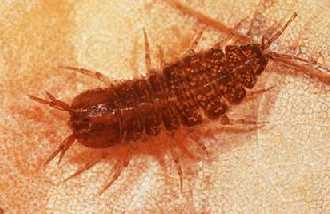Home → Water Quality → Monitoring & Reporting → Biomonitoring → Sampling & Analysis → Macroinvertebrate Types → Aquatic Sow Bugs
 Aquatic Sow Bugs (Isopoda)
Aquatic Sow Bugs (Isopoda)
Aquatic sow bugs are members of a bottom dwelling class of crustaceans called Malacostraca. This class also includes scuds (Amphipoda), crayfish and shrimp (Decapoda). Although most aquatic sow bugs live in the ocean, over 100 species are found in freshwater.
Aquatic sow bugs range from 5-20mm long and are characterized by their flat bodies with three distinct body segments (cephalothorax, thorax, and abdomen), 2 pairs of antennae, and 7 pairs of legs. Like all crustaceans, they have an exoskeleton made of both calcium carbonate (a major material in snail and mussel shells) and chitin (the same material found in human fingernails). Crustaceans reproduce sexually. Newly hatched juveniles look essentially like small adults. Crustaceans grow larger throughout their entire lives, shedding their hard exoskeleton when it is outgrown and generating a new one.
Aquatic sow bugs are secretive omnivores that feed primarily on fine detritus, dead animal matter, and decaying plants. They prefer complex, shallow habitats with lots of dark hiding places amongst cobbles, sediment, and vegetation. Aquatic sow bugs are found in a wide variety of habitats, but they are most common in seeps, springs, and small streams. They can also be found in the shallow parts of ponds and lakes.
Aquatic sow bugs absorb oxygen using gills located on the underside of the abdomen. They are somewhat tolerant of pollution, and cope especially well with organic waste. For this reason they are a reliable indicator of the zone where streams are beginning to recover from sewage pollution.
Picture key
Photo: An aquatic sow bug (Caecidotea sp.)
Source: The North American Benthological Society
Bibliography
Voshell, Jr., J. Reese; illustrated by Amy Bartlett Wright. 2002. A Guide to Common Freshwater Invertebrates of North America. Blacksburg (VA): The McDonald & Woodward Publishing Company. 442 p